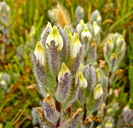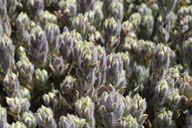Taxon Details
Chloropyron molle ssp. molle
soft salty bird's-beak
View Report Copy Link Calflora eFlora CCH CalPhotos iNaturalist
Taxon Summary:
Chloropyron molle ssp. molle, commonly known as soft salty bird's-beak, is a annual herb (hemiparasitic) in the Orobanchaceae that is found only in California. It occurs within Marshes and swamps, growing at elevations from 0 to 3 meters. Chloropyron molle ssp. molle is ranked 1B.2, Plants Rare, Threatened or Endangered in California and Elsewhere; Moderately threatened in California.|
Scientific Name: Chloropyron molle (A. Gray) A. Heller ssp. molle |
||
|
Common Name: soft salty bird's-beak |
||
| Family: | Orobanchaceae | |
| Element Code: | PDSCR0J0D2 | |
| USDA Plants Symbol: | ||
|
Synonyms/Other Names: |
||
| Name Status: |
JEF, FNA, POWO, IPNI, Tropicos |
|
| CA Rare Plant Rank: | 1B.2 |
| Fed List: | FE (1997-11-20) |
| State List: | CR (1979-07-01) |
| Global Rank: | G2T1 |
|
State Rank: |
S1 |
| Other Status: | SB_CalBG/RSABG |
|
CRPR Changes: |
|
| Add Date: | 1974-01-01 |
| Date Edited: | 2025-10-29 |
| Lifeform: annual herb (hemiparasitic) | ||||||||||||||
Blooming Period: Jun-Nov
|
||||||||||||||
|
Elevation:
0 - 3 meters 0 - 10 feet |
||||||||||||||
General Habitats:
|
||||||||||||||
| Microhabitat Details: | ||||||||||||||
|
Microhabitat:
|
||||||||||||||
|
Notes: Threatened by non-native plants, erosion, feral pigs, trampling, foot traffic, urbanization, and marsh drainage. See Proceedings of the American Academy of Arts and Sciences 7:327-402 (1867) for original description, and Madroño 25(2):107 (1978) for rediscovery in NAP Co. |
|
|
Threats: Threatened by non-native plants, erosion, feral pigs, trampling, and marsh drainage. |
|
|
Taxonomy: |
|
| Threat List Total: | 19 | |
| Total EOs | % of EOs | |
| EOs with Threat Listed: | 20 | 71 % |
| THREAT LIST: | ||
|---|---|---|
| Altered flood/tidal/hydrologic regime | 12 | 42% |
| Non-native plant impacts | 9 | 32% |
| Foot traffic/trampling | 8 | 28% |
| Grazing | 7 | 25% |
| Erosion/runoff | 6 | 21% |
| Other | 6 | 21% |
| Development | 5 | 17% |
| Feral pigs | 4 | 14% |
| Vandalism/dumping/litter | 4 | 14% |
| Recreational use (non-ORV) | 3 | 10% |
| Road/trail construction/maint. | 2 | 7% |
| Surface water diversion | 2 | 7% |
| Agriculture | 2 | 7% |
| ORV activity | 2 | 7% |
| Biocides | 2 | 7% |
| Channelization | 1 | 3% |
| Disking | 1 | 3% |
| Military operations | 1 | 3% |
| Pollution | 1 | 3% |
| Total Occurrences: | 28 | ||||
| Element Occurrence Ranks: | |||||
|---|---|---|---|---|---|
| A | B | C | D | X | U |
| 2 | 8 | 4 | 0 | 7 | 7 |
| Occurrence Status: | |||||
|---|---|---|---|---|---|
| Historical >20 Years | 15 | ||||
| Recent <=20 Years | 13 | ||||
| Presence: | |||||
|---|---|---|---|---|---|
| Presumed Extant | 21 | ||||
| Possibly Extirpated | 6 | ||||
| Presumed Extirpated | 1 | ||||
| California Endemic: | |||||||||||||
| California Island: | |||||||||||||
|
States: Name (Code) California (CA) |
|||||||||||||
|
California Counties and Islands: Name (Code) Contra Costa (CCA), Marin (MRN)*, Napa (NAP), Sacramento (SAC)*, Solano (SOL), Sonoma (SON)* |
|||||||||||||
|
Quads: Name (Quad Code) Antioch North (3812117), Benicia (3812212), Cuttings Wharf (3812223), Denverton (3812128), Fairfield South (3812221), Honker Bay (3812118), Jersey Island (3812116)*, Mare Island (3812213), Petaluma River (3812225)*, Sears Point (3812224), Vine Hill (3812211) |
|||||||||||||
Notes:
|
|||||||||||||
 Presumed Extant
Presumed Extant
Click on quad for name. Hold Shift Key to use mouse scroll wheel



